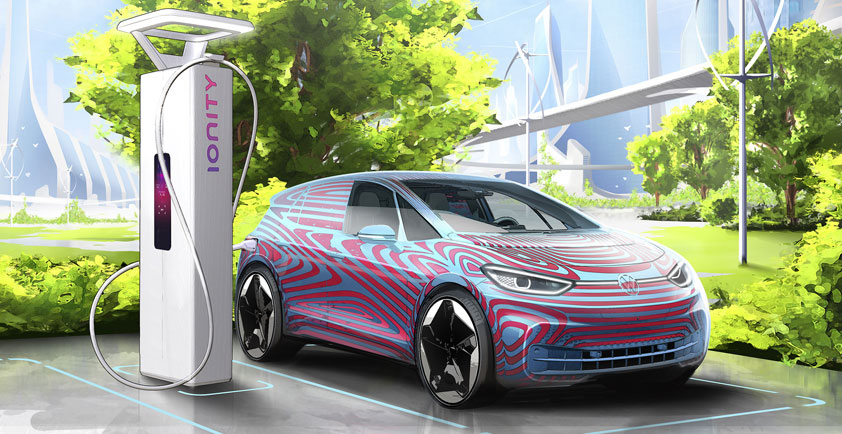

FIRST MEMBER OF THE ID. FAMILY IS CALLED ID.3
>> Start of the new all-electric family will be in compact class
>> Third major chapter in the history of the brand’s success
>> ID. stands for intelligent design, identity and visionary technologies
Months before its official world premiere at the IAA international motor show, the next milestone has already been reached: Today, Volkswagen is officially announcing the name of the first model of the new ID. family. It will be called ID.31. The number 3 is significant in two ways. On the one hand, it indicates the ID. as belonging to the compact segment, which is the class distinction in both internal and industry-wide classification systems. On the other, the ID.3 follows the Beetle and the Golf to introduce the third major chapter of strategic importance for the history of the brand.
“With the ID.3, we are starting from the centre, the Volkswagen brand’s core, in which the majority of the models and sales volume can be found. The number 3 also signals expandability into the segments above and below it. We have a lot in the pipeline,” says Jürgen Stackmann, Member of the Board of Management Volkswagen Brand for Sales, Marketing & After Sales, offering a preview of Volkswagen’s e-mobility campaign. With this campaign, the brand is willing to become the number one brand globally by 2025, with more than 20 purely electrically driven models and more than a million vehicles sold annually, all of which being both networked and emission-free.


Every member of this model family will bear the name ID., which represents a new, independent series of products in the brand portfolio. While the Beetle once mobilized the masses, and the Golf as the class leader featured great innovations in each generation, the ID. will make e-mobility accessible to a broad spectrum of customers. The name ID. stands for intelligent design, identity and visionary technologies.
Following the launch of the ID.3, additional models will roll out, such as those previewed by the concept cars ID. CROZZ, ID. VIZZION and ID. ROOMZZ, and which will in the future also be named with model numbers.
NEW ID.3 AND FUTURE ID. MODELS TO BE EQUIPPED WITH BATTERIES OFFERING THE HIGHEST CAPACITY – AND AN EIGHT-YEAR WARRANTY
>> Volkswagen will guarantee the capacity of the ID. batteries for eight years or 160,000 kilometres.
>> The batteries in the ID. family can accommodate a charging capacity of up to 125 kW, which means they can be charged very quickly on the road
>> A new range of Volkswagen wall boxes will make rapid charging a reality at home and at work
Volkswagen will launch production of the ID.31 before the year is out. The compact-class model is the first member of the ID. family – a new generation of progressive electric vehicles whose lithium-ion batteries will allow for a range of up to 550 kilometres, making the models perfect for comfortable long journeys. The future owners of ID. models won’t need to worry about the durability of their batteries either, as Volkswagen will guarantee that the batteries will retain at least 70 per cent of their usable capacity even after eight years or 160,000 kilometres.
Centre of Excellence
In 2017, Volkswagen consolidated its battery development activities at a Centre of Excellence. Among other things, this centre is responsible for ensuring that all batteries in the ID. family retain their maximum capacity over a very long period of time and are thus able to guarantee long-range operation. “Our goal is to make sure the ID. batteries last as long as the cars”, says Frank Blome, Head of the Centre of Excellence in Salzgitter.
High charging capacity makes for quick charging times
Volkswagen will offer the ID. batteries in different sizes. This marks a completely new departure as compared to the approach taken with the brand’s current range of electric vehicles. If an owner of an ID. vehicle is not really interested in being able to drive long distances (for example because they mainly only drive short distances in a city), they can opt for a battery with a relatively low energy content. This, in turn, will make their vehicle less expensive. Those who frequently drive long distances, on the other hand, can choose a larger battery, which will make them more flexible in terms of how they use their car. Depending on the battery and vehicle type in question, a maximum range of approx. 330 to 550 kilometres (WLTP) can be achieved. Volkswagen also designed the batteries to be able to accommodate a charging capacity of up to 125 kW, which is higher than anything achieved to date in the ID.3 segment and ensures fast charging and shorter charging stops.
Convenient charging at home and extremely fast charging on the move
Volkswagen expects that around 50 per cent of all charging operations will be performed at home and 20 per cent at work. A new range of wall boxes were designed with exactly this relationship in mind. These charging stations, which can be installed at home or at a business, work with charging capacities of up to 11 kilowatts (AC). The advantage here is that the charging time is much shorter than with a conventional 230-volt power supply – the wall box has enough power to charge a battery up to full power overnight or in the course of a working day. Volkswagen also believes that 25 per cent of all charging operations will occur in public spaces and five per cent at recharging stations on motorways. Depending on the driving style employed, an ID.3 with the largest battery variant would only have to be charged twice on a trip from Hamburg to Munich, or from Turin to Paris (each trip is about 800 kilometres). If the battery is charged at a fast charging station with a high capacity, around 260 kilometres of additional range (WLTP) could be charged in 30 minutes.













